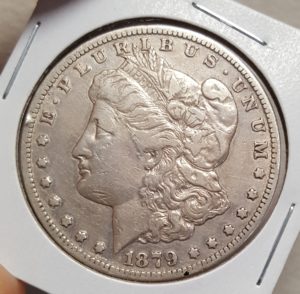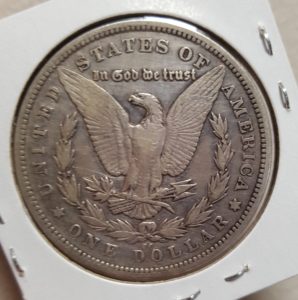Should I Clean My Coins? No!!!
Background
This question comes up all the time: “Should you clean coins?”. Without a doubt, the answer is “No!” one hundred percent of the time you should not clean coins.
As a coin ages, the metal develops a patina as a way to protect itself from the environment. Silver coins take on a gray color that can range from a light gray tone to a deeper brown tone, gold coins will develop a soft yellow color, and copper coins may develop a light brown to a dark chocolate tone. This patina, developed over years and generations, is very important to collectors who like their coins to be in their original “natural” state. There are great examples of a beautiful patina on the coins in my post HERE – Seated Liberty Half Dollars.
Cleaned Coin Example


The coin above is an 1879 Carson City (cc) Morgan Silver Dollar that I purchased not too long ago. It is a rare coin with only about 15,000 still around of the 756,000 originally minted. The auction record for this coin is $65,000 for one graded MS66 by NGC. Even in average condition, such as this one that I bought, they can fetch hundreds of dollars (this one never will!). The main problem with this Carson City Morgan is that it has been cleaned. As you can see in the photos, the obverse (front) of the coin seems to have a very nice luster to it while the reverse has a patina in varying shades of gray. The obverse of this coin also has apparent hairline scratches. The obverse of this coin has obviously been cleaned.
Unfortunately, this coin has no shot at getting graded by any third party graders solely due to the fact that it has been cleaned. If this coin was sent in to PCGS or NGC, it would be return in a slab marked “Cleaned” along with a general grade such as “Very Fine Details”. It is amazing that because one person, at one time, thought this coin “looked dirty”, this coin is permanently damaged and will never be worth what it could have.
NGC Overview of Improper Coin Cleaning
Improper Cleaning
Among the most common reasons for a coin to receive Details Grading is unskilled and improper cleaning. The temptation to “improve” a coin’s appearance by chemically or mechanically cleaning it seems acceptable, until the possible detrimental effects are later explained to the collector. Light, non-destructive cleaning, particularly when found on older coins, may still permit numeric grading. Harsher cleaning that is destructive to a coin’s aesthetic appeal, however, will result in Details Grading only, and such cleaning is not correctable with conservation.
ARTIFICIAL COLOR refers to bronze, copper and copper-nickel coins that have been chemically dipped or cleaned. Under natural conditions, most copper coins will darken over time, but examples that retain their original “red” color are highly valued. That’s why “Red Brown” (RB) or “Brown” (BN) copper coins are sometimes treated to remove this toning. The resulting color usually has an unnatural and artificial look.
BRUSHED describes a coin that has been wiped with an abrasive brush. The affected areas may be narrowed down to OBV BRUSHED or REV BRUSHED.
BURNISHED is the term used when the cleaning is more aggressive and gives the coin a very brilliant but unnatural sheen. Sometimes this action is performed with some abrasive media such as ball bearings, or it may result from treatment within a rock tumbler.
IMPROPERLY CLEANED is a generic term to describe unskilled cleaning when the exact nature of the action is uncertain.
POLISHED is similar to BURNISHED, though it’s typically applied when the abrasive action is less severe.
SPOT REMOVALS describes the unskilled, mechanical removal of “flyspecks,” small black spots of intense toning or corrosion. It also refers to similar removal of reddish “copper spots” often seen on gold coins.
SURFACE HAIRLINES are faint, abrasive lines that disturb a coin’s appearance, even though some original surface may remain underneath. They typically result from gentle rubbing with a cloth, and their severity may be described more fully through addition of the terms LIGHT, MODERATE or EXCESSIVE.
WHIZZED coins have been cleaned with a fast, rotary wire brush in order to simulate the effect of mint luster on a circulated coin. These are easily spotted by experts, as their lettering and other design details typically are distorted a bit by this action.
WIPED describes a coin that displays surface hairlines in one or more isolated areas. This is usually the result of accidental mishandling rather than intentional cleaning, but it still requires Details Grading. NGC’s graders may specify OBV WIPED or REV WIPED to more accurately describe the condition.
CoinValues Take On The Matter: When Cleaning Coins Does Far More Damage Than Simply Altering Surface Appearance
There’s a reason that a cleaned coin is often worth less than half its original, undamaged value – numismatists simply don’t want them. Many will even turn their noses up at a rare, cleaned coin from the 1790s or early 1800s if a more expensive, original version is available or soon might be.
Sometimes, cleaning coins does much more than remove its original coloration. In fact, in most cases, anything more than a simple surface rinsing with water to dislocate loose debris will actually remove tiny bits of metal from the coin. Abrasive coin cleaners, such as baking soda, toothpaste, jewelers rouge, and acids will literally remove the upper surface of the coin, leaving it in an irreparable state.
Coins cleaned in such an abusive manner have an unnatural reflectivity, and upon close inspection with a magnifying glass countless striations and hairlines can be seen scarring the surface. Sometimes these hairlines will be evident with the naked eye.
Ultimately, the thrust of this message is to encourage coin collectors to avoid cleaning their coins. An old coin in its natural state is like a fine, aged wine of a vintage from a far earlier time. Indeed, in the eyes of seasoned numismatists, a dark-hued silver dollar of 19th-century vintage is far more satisfying to own than a shiny, worn, cleaned coin with thousands upon thousands of hairlines.
TTCOINS Provides an Example of Value Differences
Third Party Grading Services (TPG’s) strongly frown upon coins which have been cleaned in the past. Cleaning coins can reduce the final grade or assessment of a coin’s condition by a significant degree depending on how harsh the cleaning was. This reduced grade ultimately reduces the value of the coins you’re trying to sell!TPG’s will label cleaned coins submitted for professional grading with a special designation “Details“. The Details designation indicates that the coin’s original surfaces are damaged or impaired. Collectors pay substantially less money for coins with this negative grading designation, as evidenced in the image below. I ran a quick search of SOLD listings on eBay for the legendary 1909-s V.D.B. Lincoln Wheat Cent. I found one graded in “AU 50” condition and one labeled “AU Details”. The cleaned “Details” coin sold for $250 less! Most TPG’s label coins as “Improperly Cleaned” below the “Details” designation, as seen below. And this, my friends, is why it’s important to not clean your coins:

